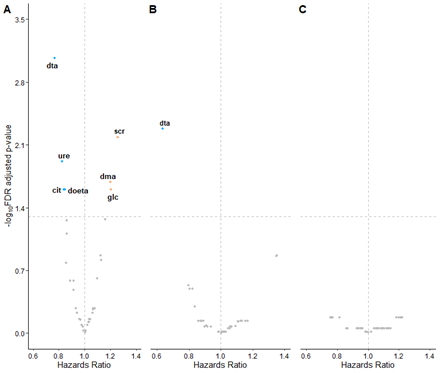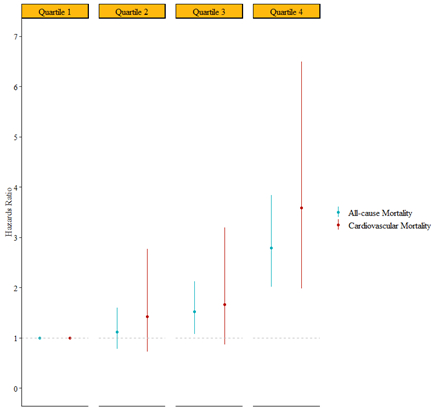Final ID: P3041
Association of Urine Metabolites with All-Cause and Cause-Specific Mortality: The Atherosclerosis Risk in Communities (ARIC) Study
Abstract Body: Introduction. Circulating metabolites are associated with all-cause and cause-specific mortality. Cardiovascular disease (CVD) and cancer are two leading causes of mortality, providing complementary assessment of disease burden in addition to all-cause mortality. However, the role of urine markers in predicting the risk of mortality is understudied.
Hypothesis. We hypothesize that urine metabolites are associated with all-cause, CVD, and cancer mortality.
Methods. Using the Nightingale platform, urine metabolite profiling was performed at the Atherosclerosis Risk in Communities (ARIC) Study visit 5 (2011-13). Urine metabolite levels were probability quotient normalized. We conducted Cox proportional models on 42 urine metabolites with all-cause, CVD, and cancer mortality, adjusting for traditional risk factors and kidney function. A metabolite risk score (MRS) was constructed using weights obtained from least absolute shrinkage and selection operator regression. Harrell’s C statistics was calculated to estimate the models’ predictive performance.
Results. Over an average of 5 years of follow-up, 372, 113, and 85 all-cause, CVD, and cancer mortality cases were developed among 1,350 participants (mean age: 75 years, 74% women, 35% Blacks). Seven and one urine metabolites were associated with all-cause and CVD mortality (FDR<0.05, Figure.1). 4-deoxythreonate, a carboxylic acid found in foods, was associated with a decreased risk of all-cause (HR per SD: 0.77, 95% CI: 0.68-0.87) and CVD (HR per SD: 0.63, 95% CI: 0.50-0.80) mortality. The highest quartile of MRS, consisting of 13 and 5 selected urine metabolites, had about a three-fold and four-fold risk of all-cause and CVD mortality compared to the lowest quartile, respectively, and a graded effect across quartiles was observed (p for trend: p<0.001, Figure.2). Adding seven significant urine metabolites improved all-cause mortality prediction by 4% over a traditional risk model (p<0.05).
Conclusions. We identified urine metabolites associated with all-cause and CVD mortality, suggesting the potential of considering urine markers in clinical practice and for at-risk population identification.
Hypothesis. We hypothesize that urine metabolites are associated with all-cause, CVD, and cancer mortality.
Methods. Using the Nightingale platform, urine metabolite profiling was performed at the Atherosclerosis Risk in Communities (ARIC) Study visit 5 (2011-13). Urine metabolite levels were probability quotient normalized. We conducted Cox proportional models on 42 urine metabolites with all-cause, CVD, and cancer mortality, adjusting for traditional risk factors and kidney function. A metabolite risk score (MRS) was constructed using weights obtained from least absolute shrinkage and selection operator regression. Harrell’s C statistics was calculated to estimate the models’ predictive performance.
Results. Over an average of 5 years of follow-up, 372, 113, and 85 all-cause, CVD, and cancer mortality cases were developed among 1,350 participants (mean age: 75 years, 74% women, 35% Blacks). Seven and one urine metabolites were associated with all-cause and CVD mortality (FDR<0.05, Figure.1). 4-deoxythreonate, a carboxylic acid found in foods, was associated with a decreased risk of all-cause (HR per SD: 0.77, 95% CI: 0.68-0.87) and CVD (HR per SD: 0.63, 95% CI: 0.50-0.80) mortality. The highest quartile of MRS, consisting of 13 and 5 selected urine metabolites, had about a three-fold and four-fold risk of all-cause and CVD mortality compared to the lowest quartile, respectively, and a graded effect across quartiles was observed (p for trend: p<0.001, Figure.2). Adding seven significant urine metabolites improved all-cause mortality prediction by 4% over a traditional risk model (p<0.05).
Conclusions. We identified urine metabolites associated with all-cause and CVD mortality, suggesting the potential of considering urine markers in clinical practice and for at-risk population identification.
More abstracts on this topic:
A Meta-Analysis on the Effect of Chronic Total Occlusion of Coronary Arteries on Cardiovascular Outcomes in Patients Undergoing Transcatheter Aortic Valve Replacement
Goyal Aman, Tariq Muhammad Daoud, Zahra Rubab, Jain Hritvik, Khan Rozi, Mahalwar Gauranga
A Novel Machine Learning Strategy to Integrate Multi-Omics Data and Detect Genomic Loci and Gene-Environment Interactions for LDL CholesterolLi Changwei, Zhang Ruiyuan, Sun Yixi, Chen Jing, Wang Tao, Bazzano Lydia, Kelly Tanika, He Jiang


